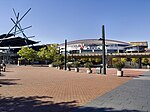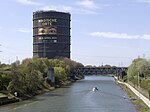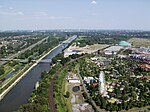LVR Industrial Museum

The Rheinisches Industriemuseum (lit. Rhineland Museum of the Industry) is a decentralized museum with six locations in Rhineland, western Germany. The locations are: Oberhausen: the main site at the old Zinkfabrik Altenberg (zinc factory), near the Oberhausen main station Ratingen: Textilfabrik Cromford (textiles factory), the first factory in continental Europe, named after the Cromford Mill Solingen: Gesenkschmiede Hendrichs (forge) Bergisch Gladbach: Papiermühle Alte Dombach (paper mill) Engelskirchen: Ermen & Engels cotton spinning mill Euskirchen: Tuchfabrik Müller (textile factory)The owner of the museum is the Landschaftsverband Rheinland (LVR).
Excerpt from the Wikipedia article LVR Industrial Museum (License: CC BY-SA 3.0, Authors, Images).LVR Industrial Museum
Hansastraße, Oberhausen Lirich (Alt-Oberhausen)
Geographical coordinates (GPS) Address Nearby Places Show on map
Geographical coordinates (GPS)
| Latitude | Longitude |
|---|---|
| N 51.474444444444 ° | E 6.8488888888889 ° |
Address
Hansastraße 18
46049 Oberhausen, Lirich (Alt-Oberhausen)
North Rhine-Westphalia, Germany
Open on Google Maps











